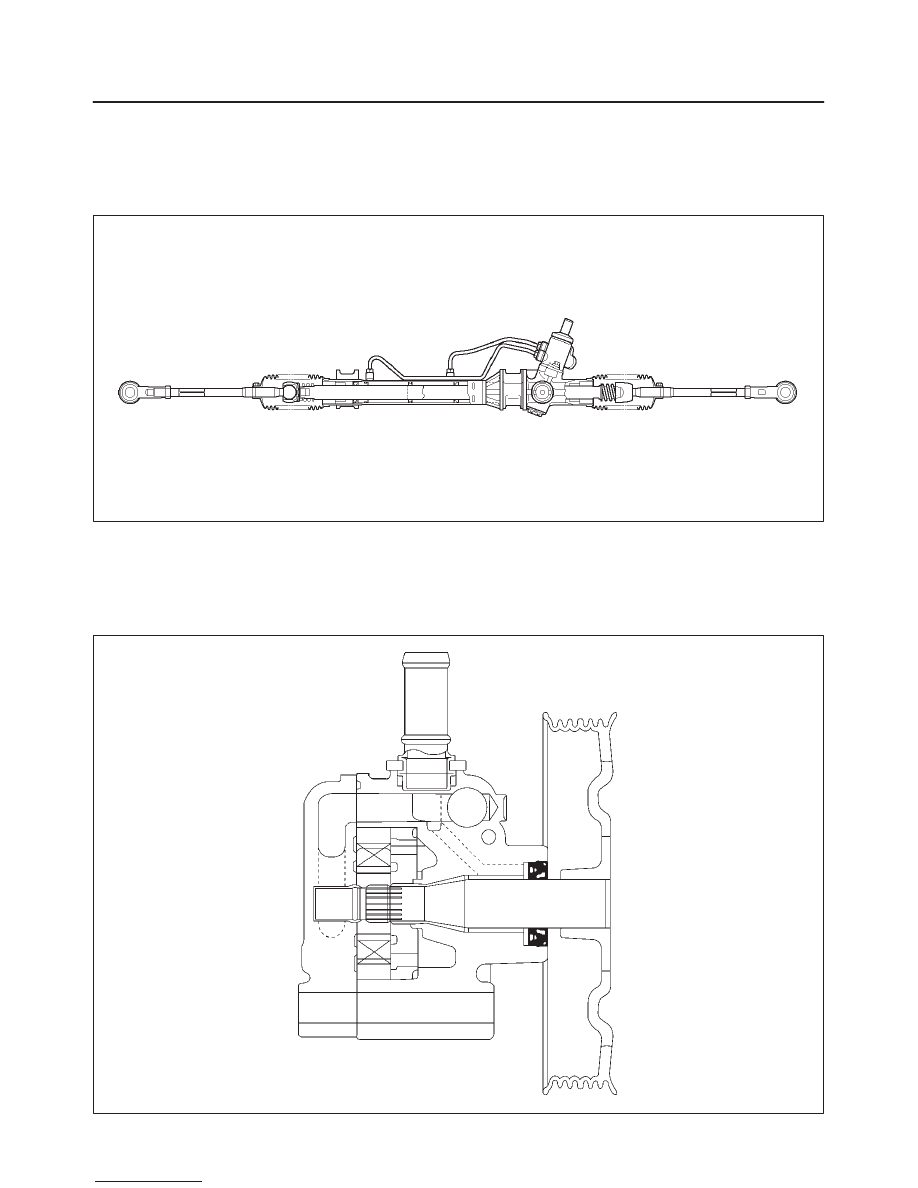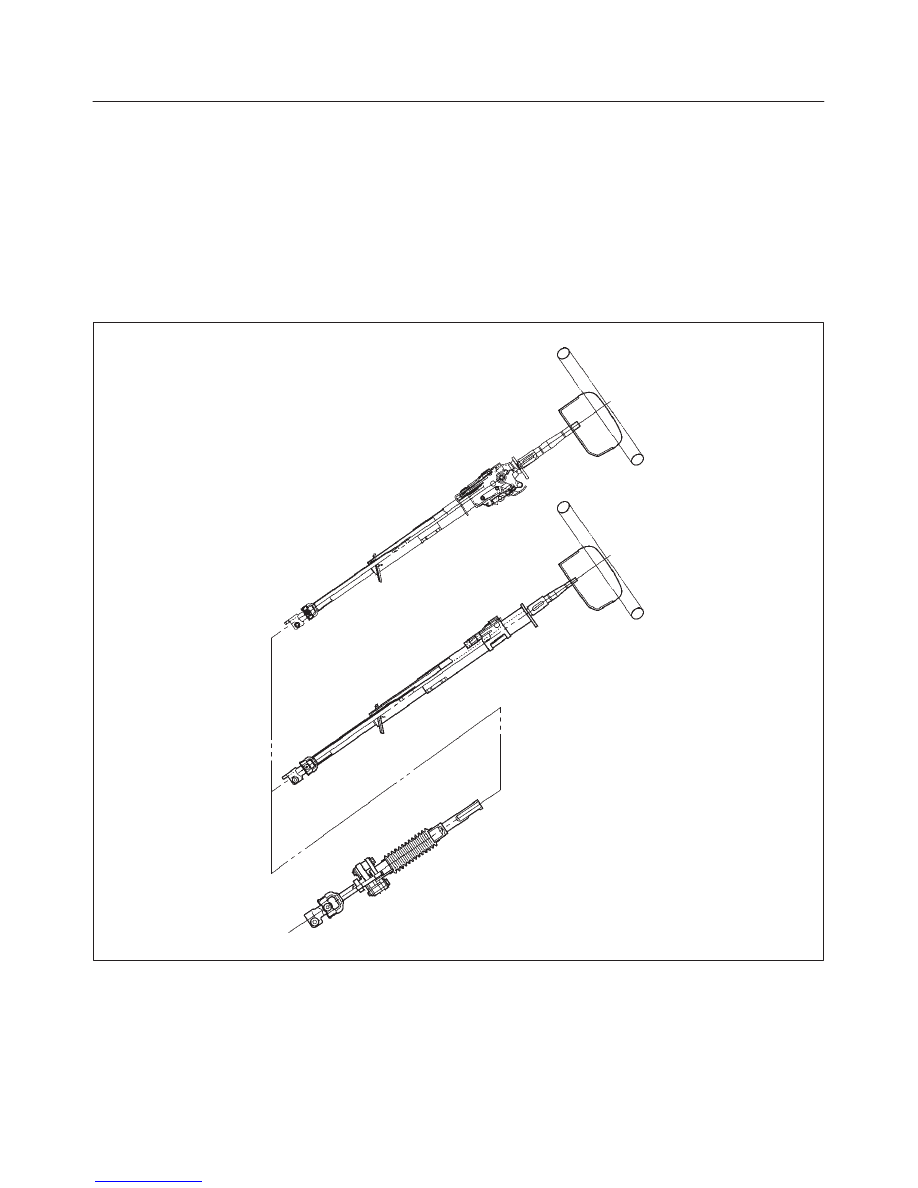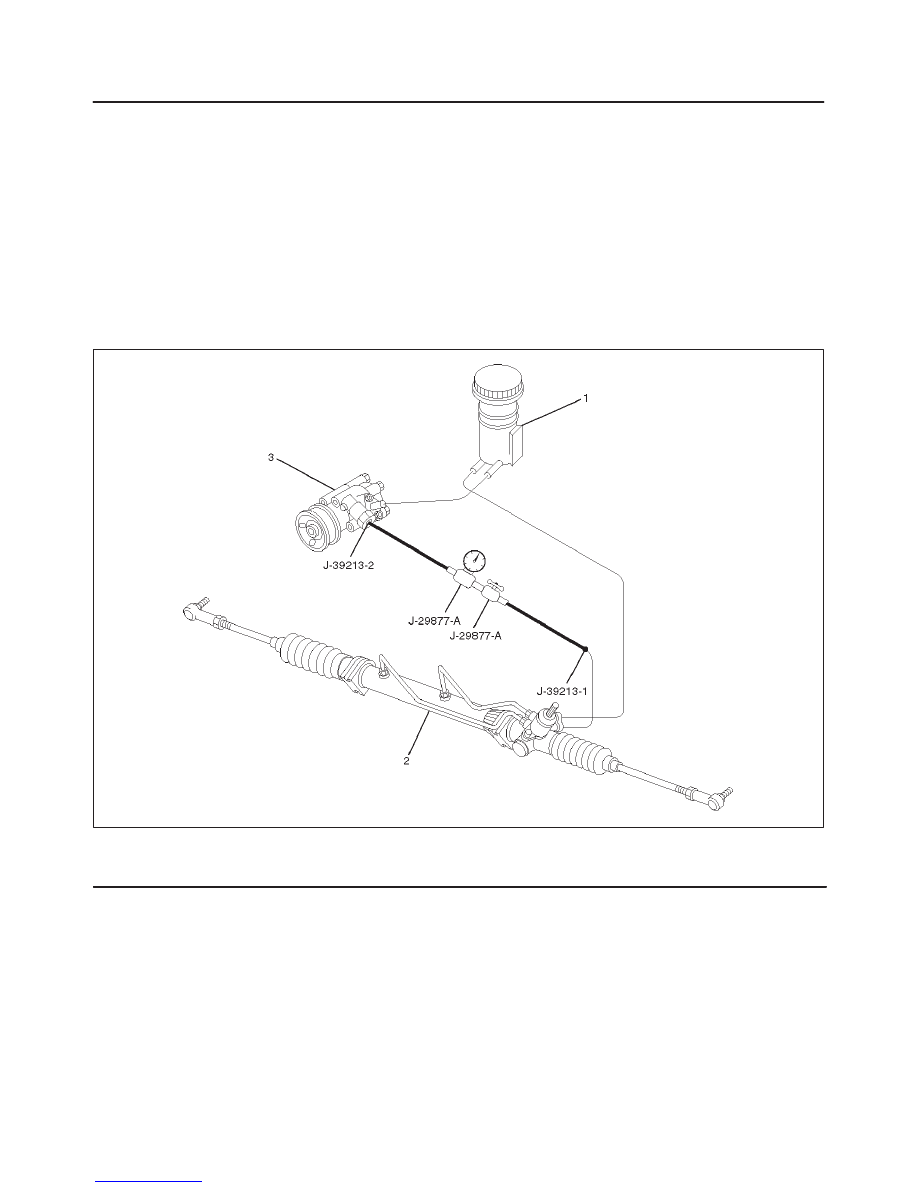Isuzu Rodeo UE. Manual — part 28

2A–8 POWER–ASSISTED STEERING SYSTEM
General Description
The hydraulic power steering system consists of a pump,
an oil reservoir, a steering unit, a pressure hose and a
return hose.
Power Steering Unit
A02RW001
The power steering unit is rack and pinion type.
The toe–in angle can be adjusted by turning the rod on
each side.
The steering housing cannot be disassembled.
Hydraulic Pump
A02RX002

POWER–ASSISTED STEERING SYSTEM
2A–9
The hydraulic pump is vane-type design. The submerged
pump has housing and internal parts that are inside the
reservoir and operate submerged in oil. There are two
bore openings at the rear of the pump housing. The larger
opening contains the cam ring, pressure plate, thrust
plate, rotor and vane assembly, and end plate. The
smaller opening contains the pressure line union, flow
control valve and spring.
The flow control orifice is part of the pressure line union.
The pressure relief valve inside the flow control valve
limits the pump pressure.
Pressure Switch
When hydraulic pressure reaches 3430 kPa (500 psi), the
pressure switch of the power steering pump closes
causing the Engine Control Module (ECM) to actuate the
idle air control valve, which increases the engine rpm to
prevent the overload-induced engine speed slow down.
The switch opens when hydraulic pressure drops to 2940
kPa (430 psi).
Steering Column
A02RX001
WARNING: TO AVOID DEPLOYMENT WHEN
TROUBLE-SHOOTING THE SRS SYSTEM, DO NOT
USE ELECTRICAL TEST EQUIPMENT, SUCH AS
BATTERY-POWERED OR A/C-POWERED
VOLT-METER, OHMMETER, ETC., OR ANY TYPE OF
ELECTRICAL EQUIPMENT OTHER THAN
SPECIFIED IN THIS MANUAL. DO NOT USE A
NON-POWERED PROBE-TYPE TESTER.
INSTRUCTION IN THIS MANUAL MUST BE
FOLLOWED CAREFULLY, OTHERWISE PERSONAL
INJURY MAY RESULT.
When servicing a vehicle equipped with Supplemental
Restraint System, pay close attention to all WARNINGS
and CAUTIONS.
For detailed explanation about SRS, refer to Restraints
section.

2A–10 POWER–ASSISTED STEERING SYSTEM
The steering column has three important features in
addition to the steering function:
1. The column is energy absorbing, designed to
compress in a front-end collision to minimize the
possibility of injury to the driver of the vehicle.
2. The ignition switch and lock are mounted
conveniently on the column.
3. With the column mounted lock, the ignition and
steering operation can be locked to prevent theft of
the vehicle.
The column can be disassembled and reassembled.
However, to insure the energy absorbing action, use only
the specified screws, bolts and nuts as designated, and
tighten them to the specified torque.
Handle the column with care when it is removed from the
vehicle. A sharp blow on the end of steering shaft or shift
lever, or dropping the assembly could shear or loosen the
fasteners that maintain column rigidity.
Power Steering System Test
Test Procedure
C02RW001
Legend
(1) Fluid Reservoir
(2) Power Steering Unit
(3) Power Steering Pump
Test of fluid pressure in the power steering system is
performed to determine whether or not the oil pump and
power steering unit are functioning normally.
The power steering system test is used to identify and
isolate hydraulic circuit difficulties. Prior to performing
this test, the following inspections and corrections, if
necessary, must be made.
f
Inspect pump reservoir for proper fluid level.
f
Inspect pump belt for proper tension.
f
Inspect pump driver pulley condition.
1. Place a container under the pump to catch the fluid
when disconnecting or connecting the hoses.
2. With the engine NOT running, disconnect the
pressure hose at the power steering pump and install
power steering tester J-29877-A. The gage must be
between the shutoff valve and pump. Open the
shutoff valve.
3. Check the fluid level. Fill the reservoir with power
steering fluid, to the “Full” mark. Start the engine,
then turn the steering wheel and momentarily hold it
against a stop (right or left). Turn the engine off and
check the connections at tester for leakage.
POWER–ASSISTED STEERING SYSTEM
2A–11
4. Bleed the system. Refer to Bleeding the Power
Steering System in this section.
5. Start the engine and check the fluid level. Add power
steering fluid if required. When the engine is at
normal operating temperature, increase engine
speed to 1500 rpm.
CAUTION: Do not leave shutoff valve fully closed
for more than 5 seconds, as the pump could become
damaged internally.
6. Fully close the shutoff valve. Record the highest
pressures.
f
If the pressure recorded is within 9300–9800 kPa
(1350–1420 psi), the pump is functioning within its
specifications.
f
If the pressure recorded is higher than 9800 kPa
(1420 psi), the valve in the pump is defective.
f
If the pressure recorded is lower than 9300 kPa
(1350 psi), the valve or the rotating group in the
pump is defective.
7. If the pump pressures are within specifications, leave
the valve open and turn (or have someone else turn)
the steering wheel fully in both directions. Record the
highest pressures and compare with the maximum
pump pressure recorded in step 6. If this pressure
cannot be built in either side of the power steering
unit, the power steering unit is leaking internally and
must be replaced.
8. Shut the engine off, remove the testing gauge.
9. Reconnect the pressure hose, check the fluid level
and make the needed repairs.
10. If the problem still exists, the steering and front
suspension must be thoroughly examined.
Maintenance
The hydraulic system should be kept clean and fluid level
in the reservoir should be checked at regular intervals and
fluid added when required. Refer to Recommended
Fluids and Lubricants in General Information section for
the type of fluid to be used and the intervals for filling.
If the system contains some dirt, flush it as described in
this section. If it is exceptionally dirty, the pump must be
completely disassembled before further usage. (The
steering unit cannot be disassembled.)
All tubes, hoses, and fittings should be inspected for
leakage at regular intervals. Fittings must be tight. Make
sure the clips, clamps and supporting tubes and hoses
are in place and properly secured.
Power steering hoses and lines must not be twisted,
kinked or tightly bent. Air in the system will cause spongy
action and noisy operation. When a hose is disconnected
or when fluid is lost, for any reason, the system must be
bled after refilling. Refer to Bleeding the Power Steering
System in this section.
f
Inspect belt for tightness.
f
Inspect pulley for looseness or damage. The pulley
should not wobble with the engine running.
f
Inspect hoses so they are not touching any other
parts of the vehicle.
f
Inspect fluid level and fill to the proper level.
Fluid Level
1. Run the engine until the power steering fluid reaches
normal operating temperature, about 55
°
C (130
°
F),
then shut the engine off.
2. Check the level of fluid in the reservoir.
3. If the fluid level is low, add power steering fluid as
specified in General Information to the proper level
and install the receiver cap.
4. When checking the fluid level after the steering
system has been serviced, air must be bled from the
system. Refer to Bleeding the Power Steering
System in this section.
Bleeding The Power Steering System
When a power steering pump or unit has been installed,
or an oil line has been disconnected, the air that has
entered the system must be bled out before the vehicle is
operated. If air is allowed to remain in the power steering
fluid system, noisy and unsatisfactory operation of the
system may result.
Bleeding Procedure
When bleeding the system, and any time fluid is added to
the power steering system, be sure to use only power
steering fluid as specified in General Information.
1. Fill the pump fluid reservoir to the proper level and let
the fluid settle for at least two minutes.
2. Start the engine and let it run for a few seconds. Do
not turn the steering wheel. Then turn the engine off.
3. Add fluid if necessary.
4. Repeat the above procedure until the fluid level
remains constant after running the engine.
5. Raise and support the front end of the vehicle so that
the wheels are off the ground.
6. Start the engine. Slowly turn the steering wheel right
and left, lightly contacting the wheel stops.
7. Add power steering fluid if necessary.
8. Lower the vehicle, set the steering wheel at the
straight forward position after turning it to its full steer
positions 2 or 3 times, and stop the engine.
9. Check the fluid level and refill as required.
10. If the fluid is extremely foamy, allow the vehicle to set
a few minutes, then repeat the above procedure.
Flushing The Power Steering System
1. Raise and support the front end of the vehicle off the
ground until the wheels are free to turn.
2. Remove the fluid return line at the pump inlet
connector and plug the connector port on the pump.
Position the line toward a large container to catch the
draining fluid.
3. While running the engine at idle, fill the reservoir with
new power steering fluid. Turn the steering wheel in
both directions. Do not contact or hold the steering
wheel to the wheel stops. This will cause the pump to
go to pressure relief mode, which may cause a
sudden fluid overflow at the reservoir.

Нет комментариевНе стесняйтесь поделиться с нами вашим ценным мнением.
Текст